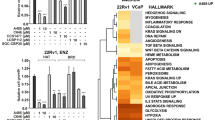Abstract
Aryl hydrocarbon-receptor nuclear translocator (ARNT2) is a member of the bHLH PAS (basic helix–loop–helix Period/ARNT/Single-minded) family of transcription factors. Recently, some studies indicate that ARNT2 is associated with the occurrence and development of carcinoma. However, its roles in gastric cancer (GC) remain unclear. In the present study, we found that ARNT2 expression level is lower in GC tissues compared with adjacent non-tumor tissues, and negatively correlated with depth of invasion of the tumor, differentiated degree, and poor survival of GC patients. Overexpression of ARNT2 inhibits cell proliferation. Furthermore, AKT pathway contributed to ARNT2 -mediated PC proliferation. Taken together, our results provide the first evidence that high expression of ARNT2 inhibited proliferation of GC cells and affected tumor aggressiveness in GC patients.




Similar content being viewed by others
References
Liou JM, Fang YJ, Chen CC, Bair MJ, Chang CY, Lee YC, Chen MJ, Chen CC, Tseng CH, Hsu YC, Lee JY, Yang TH, Luo JC, Chang CC, Chen CY, Chen PY, Shun CT, Hsu WF, Hu WH, Chen YN, Sheu BS, Lin JT, Wu JY, El-Omar EM, Wu MS, Taiwan Gastrointestinal D, Helicobacter C (2016) Concomitant, bismuth quadruple, and 14-day triple therapy in the first-line treatment of Helicobacter pylori: a multicentre, open-label, randomised trial. Lancet 388(10058):2355–2365. https://doi.org/10.1016/S0140-6736(16)31409-X
Hirose K, Morita M, Ema M, Mimura J, Hamada H, Fujii H, Saijo Y, Gotoh O, Sogawa K, Fujii-Kuriyama Y (1996) cDNA cloning and tissue-specific expression of a novel basic helix-loop-helix/PAS factor (Arnt2) with close sequence similarity to the aryl hydrocarbon receptor nuclear translocator (Arnt). Mol Cell Biol 16(4):1706–1713
Hankinson O (2008) Why does ARNT2 behave differently from ARNT? Toxicol Sci 103(1):1–3. https://doi.org/10.1093/toxsci/kfn032
Aitola MH, Pelto-Huikko MT (2003) Expression of Arnt and Arnt2 mRNA in developing murine tissues. J Histochem Cytochem 51(1):41–54. https://doi.org/10.1177/002215540305100106
Bersten DC, Sullivan AE, Peet DJ, Whitelaw ML (2013) bHLH-PAS proteins in cancer. Nat Rev Cancer 13(12):827–841. https://doi.org/10.1038/nrc3621
Drutel G, Kathmann M, Heron A, Schwartz JC, Arrang JM (1996) Cloning and selective expression in brain and kidney of ARNT2 homologous to the Ah receptor nuclear translocator (ARNT). Biochem Biophys Res Commun 225(2):333–339. https://doi.org/10.1006/bbrc.1996.1176
Keith B, Adelman DM, Simon MC (2001) Targeted mutation of the murine arylhydrocarbon receptor nuclear translocator 2 (Arnt2) gene reveals partial redundancy with Arnt. Proc Natl Acad Sci USA 98(12):6692–6697. https://doi.org/10.1073/pnas.121494298
Zudaire E, Cuesta N, Murty V, Woodson K, Adams L, Gonzalez N, Martinez A, Narayan G, Kirsch I, Franklin W, Hirsch F, Birrer M, Cuttitta F (2008) The aryl hydrocarbon receptor repressor is a putative tumor suppressor gene in multiple human cancers. J Clin Investig 118(2):640–650. https://doi.org/10.1172/JCI30024
Yang B, Yang E, Liao H, Wang Z, Den Z, Ren H (2015) ARNT2 is downregulated and serves as a potential tumor suppressor gene in non-small cell lung cancer. Tumour Biol 36(3):2111–2119. https://doi.org/10.1007/s13277-014-2820-1
Li W, Liang Y, Yang B, Sun H, Wu W (2015) Downregulation of ARNT2 promotes tumor growth and predicts poor prognosis in human hepatocellular carcinoma. J Gastroenterol Hepatol 30(6):1085–1093. https://doi.org/10.1111/jgh.12905
Hao N, Bhakti VL, Peet DJ, Whitelaw ML (2013) Reciprocal regulation of the basic helix-loop-helix/Per-Arnt-Sim partner proteins, Arnt and Arnt2, during neuronal differentiation. Nucleic Acids Res 41(11):5626–5638. https://doi.org/10.1093/nar/gkt206
Liu C, Goshu E, Wells A, Fan CM (2003) Identification of the downstream targets of SIM1 and ARNT2, a pair of transcription factors essential for neuroendocrine cell differentiation. J Biol Chem 278(45):44857–44867. https://doi.org/10.1074/jbc.M304489200
Kimura Y, Kasamatsu A, Nakashima D, Yamatoji M, Minakawa Y, Koike K, Fushimi K, Higo M, Endo-Sakamoto Y, Shiiba M, Tanzawa H, Uzawa K (2016) ARNT2 Regulates tumoral growth in oral squamous cell carcinoma. J Cancer 7(6):702–710. https://doi.org/10.7150/jca.14208
Qin XY, Zaha H, Nagano R, Yoshinaga J, Yonemoto J, Sone H (2011) Xenoestrogens down-regulate aryl-hydrocarbon receptor nuclear translocator 2 mRNA expression in human breast cancer cells via an estrogen receptor alpha-dependent mechanism. Toxicol Lett 206(2):152–157. https://doi.org/10.1016/j.toxlet.2011.07.007
Maltepe E, Keith B, Arsham AM, Brorson JR, Simon MC (2000) The role of ARNT2 in tumor angiogenesis and the neural response to hypoxia. Biochem Biophys Res Commun 273(1):231–238. https://doi.org/10.1006/bbrc.2000.2928
Sekine H, Mimura J, Yamamoto M, Fujii-Kuriyama Y (2006) Unique and overlapping transcriptional roles of arylhydrocarbon receptor nuclear translocator (Arnt) and Arnt2 in xenobiotic and hypoxic responses. J Biol Chem 281(49):37507–37516. https://doi.org/10.1074/jbc.M606910200
Qin XY, Wei F, Yoshinaga J, Yonemoto J, Tanokura M, Sone H (2011) siRNA-mediated knockdown of aryl hydrocarbon receptor nuclear translocator 2 affects hypoxia-inducible factor-1 regulatory signaling and metabolism in human breast cancer cells. FEBS Lett 585(20):3310–3315. https://doi.org/10.1016/j.febslet.2011.09.017
Acknowledgements
This work was financially supported by the National Natural Science Foundation of China (No. 31671468 and 81602593), the Chinese Postdoctoral Science Foundation (No. 2016M602152), the Shandong Provincial Natural Science Foundation of China (No. 2016ZRA01062, ZR2015HM018, ZR2017MH071, and ZR2012HM061), and the Jinan Postdoctoral Innovation Project (172634).
Author information
Authors and Affiliations
Corresponding authors
Ethics declarations
Conflict of interest
The authors declare that they have no conflict of interest.
Rights and permissions
About this article
Cite this article
Jia, Y., Hao, S., Jin, G. et al. Overexpression of ARNT2 is associated with decreased cell proliferation and better prognosis in gastric cancer. Mol Cell Biochem 450, 97–103 (2019). https://doi.org/10.1007/s11010-018-3376-y
Received:
Accepted:
Published:
Issue Date:
DOI: https://doi.org/10.1007/s11010-018-3376-y




